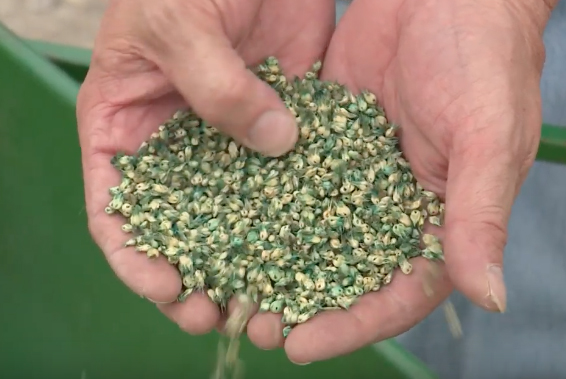Sarah Browning, Nebraska Extension Educator

Dormant Turf Seeding - Images from Nebraska Extension Backyard Farmer
Traditionally, we think of seeding lawns in either spring (April-May) or fall (August-September). But increasingly, turf specialists are recommending a new option - dormant seeding. With this method, the area is prepared in fall but the seed is not distributed until after the growing season has ended. Seed remains in place, but does not begin to grow until soil temperatures are warm enough for germination in mid-April.

Soil Preparation Creates a Good Seedbed
The actual process of seedbed preparation is the same as other times of the year, but dormant seeding is most effective when soil preparation, such as core aeration, power-raking, tilling, or some other form of cultivation is done in fall. Simply broadcasting seed and allowing it to work into the soil naturally through frost-heaving might be effective; but having soil preparation done first to improve seed-soil contact is important for successful dormant-seeding.
Prepare small areas by hand raking to remove excess dead top growth and loosen the soil surface. The best technique for preparing larger areas is aerating. Aeration opens up the soil and provides a good surface for seed germination. Seeds that fall into the aeration holes will germinate and grow well; there is no need to topdress or fill in the holes before seeding.
Power raking can also be used to prepare the site, but is more damaging to existing turf. The only benefit of power raking over aeration is to reduce excess thatch, if more than a ½” thatch layer is present. If power raking is used, go over the turf lightly only deep enough to penetrate the top ¼” of soil.
Seeding
Once seedbed preparation is done, dormant seeding should ideally take place from mid-December through mid-February. Soil temperatures must be 40 degrees F or below to ensure seeds will not germinate. Since the seed needs to have good soil contact, don’t apply seed over snow. Dormant seeding should be done no later than March 15th.
The seeding rate for new, bare lawn areas is as follows: Kentucky bluegrass 2-3 lbs. per 1,000 sq.ft. and tall fescue 6-8 lbs. per 1,000 sq.ft.
The amount of seed applied when overseeding into a thin lawn is usually half the amount used for a new seeding. Kentucky bluegrass should be applied at 1-2 lbs. per 1,000 sq.ft. and tall fescue at 3-4 lbs. of seed per 1,000 sq.ft. When working with small amounts of seed, mix sawdust, dry sand or any other suitable material with the seed to aid in obtaining uniform coverage.
Fertilization and Weed Control
Applying a pre-emergent herbicide for weed control can be done with new seedings, but use only the pre-emergent herbicide Siduron, commonly sold as Tupersan. This herbicide will provide good control of annual grassy weeds like crabgrass and foxtail, yet still allow the grass seed to germinate.
Do not apply the pre-emergent herbicide when you broadcast the seed. Pre-emergent herbicide applied too early is a waste because it will begin to degrade before weed control is needed and won't provide effective control when weed seeds do begin to germinate.
Instead, wait until mid-April and the first week of May to apply. Several days of soil temperatures 55 degrees F or above are required for crabgrass and foxtail seeds to germinate. Be sure the pre-emergent herbicide is in place before that time. Monitor your local soil temperature at Nebraska Extension’s Hort Update, http://hortupdate.unl.edu.
For new seedings, use the lower recommended rate and repeat the application one month later.
Pre-emergent herbicide is usually combined with a starter fertilizer for new seedings. A combination application made between mid-April and the first week of May is a good way to provide fertility and control weeds at the same time.
Watering
Don’t rely solely on spring rain for germination of your new seeding. Begin watering the seeds 2-4 times per day in late April to ensure good germination. Base your watering schedule on weather conditions and how fast the soil dries. Water frequently enough to keep the top ½-1 inch of soil moist, but avoid over-watering and saturating the area.
Watch Winter Weather Conditions
One risk involved with dormant seeding is warm winter and early spring temperatures. If conditions cause seed to germinate and are followed by a cold period, seedlings may be killed. Continuous snow cover provides the best protection for seeds.
Monitor seeded areas in mid-spring for the need to do additional overseeding, but give the seeds plenty of time to germinate.
For More Information
Dormant Turf Seeding, Backyard Farmer
Establishing Lawns from Seed, Nebraska Extension
Images from Nebraska Extension Backyard Farmer.
Search Our Archive
Associated Video
Buffalograss Seeding
UNL Extension Turfgrass Specialist Zac Reicher shows how to seed buffalograss